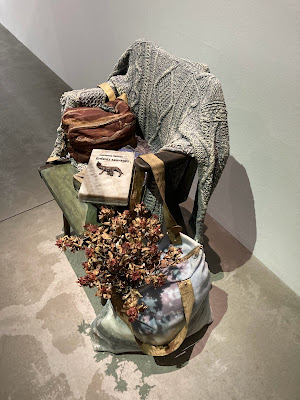 |
| Tatiana Trouvé, The Guardian, 2022 |
In the Pompidou exhibition, as always, The Guardian examples sit quietly, unassumingly, at the edges of the room, to the side of the other works. I waited and watched other visitors, only to see them ignore the seats filled with someone's belongings. They chairs are so understated and discrete, to the point where they don't ask to be looked at like art works. And yet, they are art works. They are intricately crafted from bronze, marble, onyx, brass and sodalite. The sculptures are fascinating and inviting when we recognize the work that has gone into making hard, inflexible materials into lusciously soft fabrics and objects.
This exhibition also includes a wall of Trouvé's lockdown drawings that she made on the covers of the world's leading newspapers. Trouvé draws her bed, her dog, her wardrobe, her everyday life in her studio over the top of the dramatic headlines that accompanied us through the months from March to May (2020). The superimposition of the everyday over the devastating news of death and disease, the recounting of numbers and alarming headlines often acting as warnings, makes obvious sense. This is how we all lived in lockdown; our ordinary lives and a world in crisis outside our doors overlaid each other for months on end. As I browsed the warnings of war, death knells and governments on their knees, I was astounded at how far away it all seemed. When I think about how consumed we all were by statistics, masks, government restrictions, and vaccines, and yet, today, most days, it doesn't even cross my mind that we are not even one year out of a global pandemic.



No comments:
Post a Comment